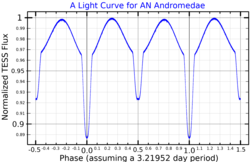| Observation data Epoch J2000 Equinox J2000 | |
|---|---|
| Constellation | Andromeda |
| Right ascension | 23h 18m 23.32202s[2] |
| Declination | +41° 46′ 25.2031″[2] |
| Apparent magnitude (V) | 5.98[3] |
| Characteristics | |
| Spectral type | A7 V[4] or A7m[3] |
| B−V color index | 0.215±0.002[3] |
| Variable type | β Lyr[5] |
| Astrometry | |
| Radial velocity (Rv) | −3.8±2.9[3] km/s |
| Proper motion (μ) | RA: −10.266[2] mas/yr Dec.: −9.791[2] mas/yr |
| Parallax (π) | 7.0976 ± 0.0544 mas[2] |
| Distance | 460 ± 4 ly (141 ± 1 pc) |
| Absolute magnitude (MV) | 0.43[3] |
| Orbit[6] | |
| Period (P) | 3.2196 d |
| Eccentricity (e) | 0.03 |
| Inclination (i) | 60.2[7]° |
| Periastron epoch (T) | 2,436,094.876 JD |
| Semi-amplitude (K1) (primary) | 71.6 km/s |
| Details[7] | |
| 9 And A | |
| Mass | 2.48 M☉ |
| Radius | 3.51 R☉ |
| Luminosity | 49.2 L☉ |
| Temperature | 8,200 K |
| Rotational velocity (v sin i) | 81[8] km/s |
| 9 And B | |
| Mass | 1.32 M☉ |
| Luminosity | 17.5 L☉ |
| Temperature | 6,330 K |
| Other designations | |
| Database references | |
| SIMBAD | data |
9 Andromedae, abbreviated 9 And by convention, is a variable binary star system in the northern constellation Andromeda. 9 Andromedae is the Flamsteed designation, while it bears the variable star designation AN Andromedae, or AN And. The maximum apparent visual magnitude of the system is 5.98,[3] which places it near the lower limit of visibility to the human eye. Based upon an annual parallax shift of 7.1 mas,[2] it is located 460 light years from the Earth.
This system was determined to be a single-lined spectroscopic binary in 1916 by American astronomer W. S. Adams, and the initial orbital elements were computed by Canadian astronomer R. K. Young in 1920.[7] The pair orbit each other with a period of 3.2196 days and an eccentricity of 0.03.[6] It is an eclipsing binary, which means the orbital plane is inclined close to the line of sight and, from the perspective of the Earth, the stars pass in front of each other, causing two partial eclipses every orbit. During the transit of the secondary in front of the primary, the visual magnitude drops to 6.16, while the eclipse of the secondary by the primary lowers the net magnitude to 6.09.[10]
- ^ Cite error: The named reference
MASTwas invoked but never defined (see the help page). - ^ a b c d e f Cite error: The named reference
GaiaDR2was invoked but never defined (see the help page). - ^ a b c d e f Cite error: The named reference
Anderson2012was invoked but never defined (see the help page). - ^ Cite error: The named reference
Hill1975was invoked but never defined (see the help page). - ^ Cite error: The named reference
gcvswas invoked but never defined (see the help page). - ^ a b Cite error: The named reference
Pourbaix2004was invoked but never defined (see the help page). - ^ a b c Cite error: The named reference
Tremko1978was invoked but never defined (see the help page). - ^ Cite error: The named reference
Royer2002was invoked but never defined (see the help page). - ^ Cite error: The named reference
SIMBADwas invoked but never defined (see the help page). - ^ Cite error: The named reference
Avvakumova2013was invoked but never defined (see the help page).
